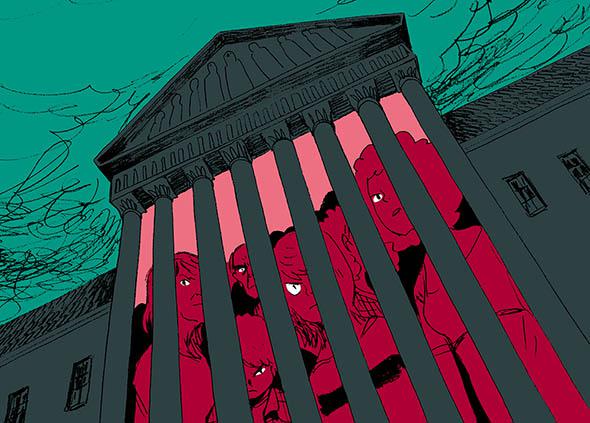In America at the dawn of the 20th century, 25,000 little boys spent 10 hours a day in the living hell known as a coal mine. Charged with pulling detritus out of coal shipments, boys as young as 8 hunched over an ever-flowing stream of minerals, plunging in their hands to pull out slate and other rubbish. Many lost fingers or had limbs torn off by faulty machinery. Some fell down coal chutes and were smothered to death. Most, later in life, experienced horrific medical conditions like black lung. For this work, they were paid 40 cents a day.
Disgusted by these savage working conditions and vexed by individual states’ refusal to take action, Congress passed a law in 1916 that forbade the interstate shipment of any good produced in a factory that employed children under age 14. Conservative activists quickly contrived a lawsuit against the act—and won at the Supreme Court, where five justices declared the child labor law unconstitutional. Although the Constitution explicitly grants Congress the power to regulate commerce between the states, the court explained, Congress here had illegitimately used this power to ban child labor. Why was that exercise of constitutional power illegitimate? Because five justices said so. The law was invalidated, and the 8-year-olds went back to the mines.
As Ian Millhiser illustrates in his trenchant, persuasive, and profoundly dispiriting book Injustices, the Supreme Court has consistently and unapologetically used its authority to thwart progress and perpetuate inequality. The child labor disaster is, if you can believe it, one of the less appalling stories in the book. For as long as the court has held the power to strike down laws—a power it created—its justices have used this authority to impose their own antiquated, antidemocratic ideas on the country at large. Millhiser repeatedly ponders why the court has so persistently hindered self-rule and social progress. The better question to ask about the court, however, is a more basic one: Why do we still put up with it?
You wouldn’t guess it from the confidence with which today’s justices invalidate legislation, but it’s actually not clear that the founders intended to give the Supreme Court final say over the Constitution’s meaning. Sure, Article III envisions “one Supreme Court” in which judicial power is vested, and Article VI makes the Constitution the “supreme law of the land.” But nowhere does the Constitution explicitly state that the Supreme Court gets to say, conclusively and with binding authority, how America’s founding document can and cannot be applied.
Given that ambiguous silence, shouldn’t Congress, too, get to play some role in interpreting the Constitution’s majestic generalities? When duly elected representatives of the people find that legislation grants “due process of law” and “equal protection,” shouldn’t that decision be accorded deference by nine unelected judges? And in a constitutional food fight between Congress and the court, shouldn’t the democratic process win out over the labyrinthine legal doctrines dreamed up by lawyers?
Injustices doesn’t quite confront these questions head-on. Instead, Millhiser—a former federal appeals court clerk and a writer for ThinkProgress—describes what happens when legislatures simply cede interpretive authority to a court swollen with power. The most galling portion of the book charts the court’s perversion of a key component of the Constitution, due process. After the Civil War, Congress passed (and the states ratified) the 14th Amendment, which stated in part that no state may deprive a person of “life, liberty or property without due process of law.” This clause had two functions. First, it forbade states from distorting the judicial system in order to deprive newly freed slaves of fair trials. Second, it barred states from enacting laws so deleterious to individual liberty, so contrary to fundamental rights, that they could not qualify as “law” at all.
The due process clause, then, was obviously designed to protect personal freedom. Yet, for decades, a business-friendly Supreme Court used it to strike down laws that regulated businesses in order to protect workers from hazardous conditions. In 1905, five conservative justices struck down a New York law that limited bakers to working 60 hours a week and 10 hours in any single day. (Prior to this law, impoverished bakers were frequently forced to work 24-hour shifts in squalid, roach-infested conditions.) According to the court, this modest regulation violated the “liberty” of bakery owners to negotiate contracts with their employees—and employees’ “liberty” to work brutally long shifts—without “due process of law.” Under this preposterous theory, the court struck down maximum hour and minimum wage laws for the next 32 years.
This era of antidemocratic judicial arrogance reached its peak in the early days of the New Deal, when conservative justices struck down legislation regulating national industries, taxing food production, and creating pension systems for railway workers. Then, in 1937—possibly in response to nationwide outcry—the court pulled back from the brink, completely reversing course and abandoning its reactionary doctrines. Seventeen years later, the court handed down Brown v. Board of Education, striking a judicial blow against racial segregation and launching the golden years of the Warren Court. In short order, the newly liberal court issued rulings that vastly expanded the rights of the accused, the poor, and minorities. But this era turned out to be fleeting, and by the 1970s and ’80s, the court—stacked with Republican appointees—relapsed into stinginess, once again depriving minorities and the poor of equal justice.
How has the Supreme Court gotten away with so much bad behavior for so long? It has no army to enforce its rulings, no police force to ensure compliance. In pragmatic terms, there are probably three things that keep American law tethered to the court. First, most of us, especially those in government, simply feel like there’s no other option but to follow the justices’ orders. That’s because the court has positioned itself at the pinnacle of American democracy, seizing a constitutional high ground and declaring its own decrees to be ironclad and incontestable. (The justices once infamously proclaimed that they were empowered to call “the contending sides of a national controversy to end their national division.”)
Second, some sizable number of legislators will usually agree with any given ruling and can push the government to conform to it, as when conservative state representatives eagerly accepted the Supreme Court’s invitation to reject Obamacare’s Medicaid expansion. Third, the court truly does stand as the final resort for unpopular minorities: In the last century, it has (somewhat inconsistently) protected religious liberty, free expression, racial and gender equality, reproductive freedom, sexual autonomy, and equal dignity for gays and lesbians.
Are these triumphs enough to justify our tolerance for the court’s graver missteps? Like Millhiser, I’m starting to doubt it. The court’s great liberal rulings arrived only after a majority of Americans already agreed that a certain constitutional right exists. When the court struck down contraceptive bans, few states still enforced theirs. When it legalized same-sex sodomy, only four states specifically criminalized gay relationships. Brown v. Board of Education, the greatest decision of all time, had hardly any immediate effect on segregated schools; widespread integration only occurred after Congress stepped in 10 years later with the Civil Rights Act.

Photo courtesy Center for American Progress
On this record, I’m not sure America’s experiment with judicial supremacy has been a great success. Its finest moments have merely crystallized an emerging public sentiment; its bravest rulings have been widely ignored; its worst decisions have devastated the lives of the less fortunate. There’s essentially no rein on the court’s power, no check on its ability to manipulate the law to the detriment of democracy and equality. The justices’ willingness to support minority rights like gay marriage means many of us still look upon them fondly (and hopefully). But at some point, the occasional victory for minorities may no longer justify the constant slew of disturbing decisions designed to aid the powerful.
Under Chief Justice John Roberts, today’s court has edged closer to the abyss each year. Already this term, the conservative justices look poised to strike down an anti-gerrymandering law and a restraint on judicial campaign finance. The court could also strip 8.2 million Americans of their health insurance thanks to a malicious, mendacious lawsuit. And over the last decade, the court carefully planted time bombs that could soon obliterate campaign finance restrictions, willfully marching America toward an oligarchy. These rulings aren’t just minor missteps: They pose a real threat to democracy, seriously undermining Americans’ ability to govern themselves.
How much of this corrosion of democracy are we willing to take? And what happens when we put our foot down? Injustices flirts with these questions but ultimately shies away from any definitive answer. But of course, the solution here is obvious: If we want to curb the Supreme Court’s power, all we have to do is ignore it. Issue enough rulings that antagonize both liberals and conservatives, and the court might just castrate itself, leading legislatures in red and blue states alike to start ignoring its proclamations. That’ll be a sad fate for a briefly great institution—but also a happy day for American democracy. At bottom, the Supreme Court exists to enforce the rule of law. When the justices break that rule themselves, the remedy is obvious: The court has got to go.
—
Injustices by Ian Millhiser. Nation Books.
See all the pieces in this month’s Slate Book Review.
Sign up for the Slate Book Review monthly newsletter.
